Case Study Analysis: B.R. Richardson Timber Products Corporation
VerifiedAdded on 2020/03/23
|10
|2722
|48
Case Study
AI Summary
This report provides a comprehensive case study analysis of the B.R. Richardson Timber Products Corporation. It examines the challenges faced by the company, particularly concerning employee motivation and organizational development, through the lens of the case study. The analysis critically evaluates the strategies employed by management, including the application of various organizational development theories. The report diagnoses the situation, identifies alternative solutions, and presents recommendations for improvement, emphasizing the importance of market analysis, employee engagement, and a well-defined action plan. The study highlights the need for leadership to foster a positive work environment and address employee concerns to enhance overall organizational effectiveness. The conclusion summarizes the key findings and reinforces the importance of a proactive approach to organizational development.
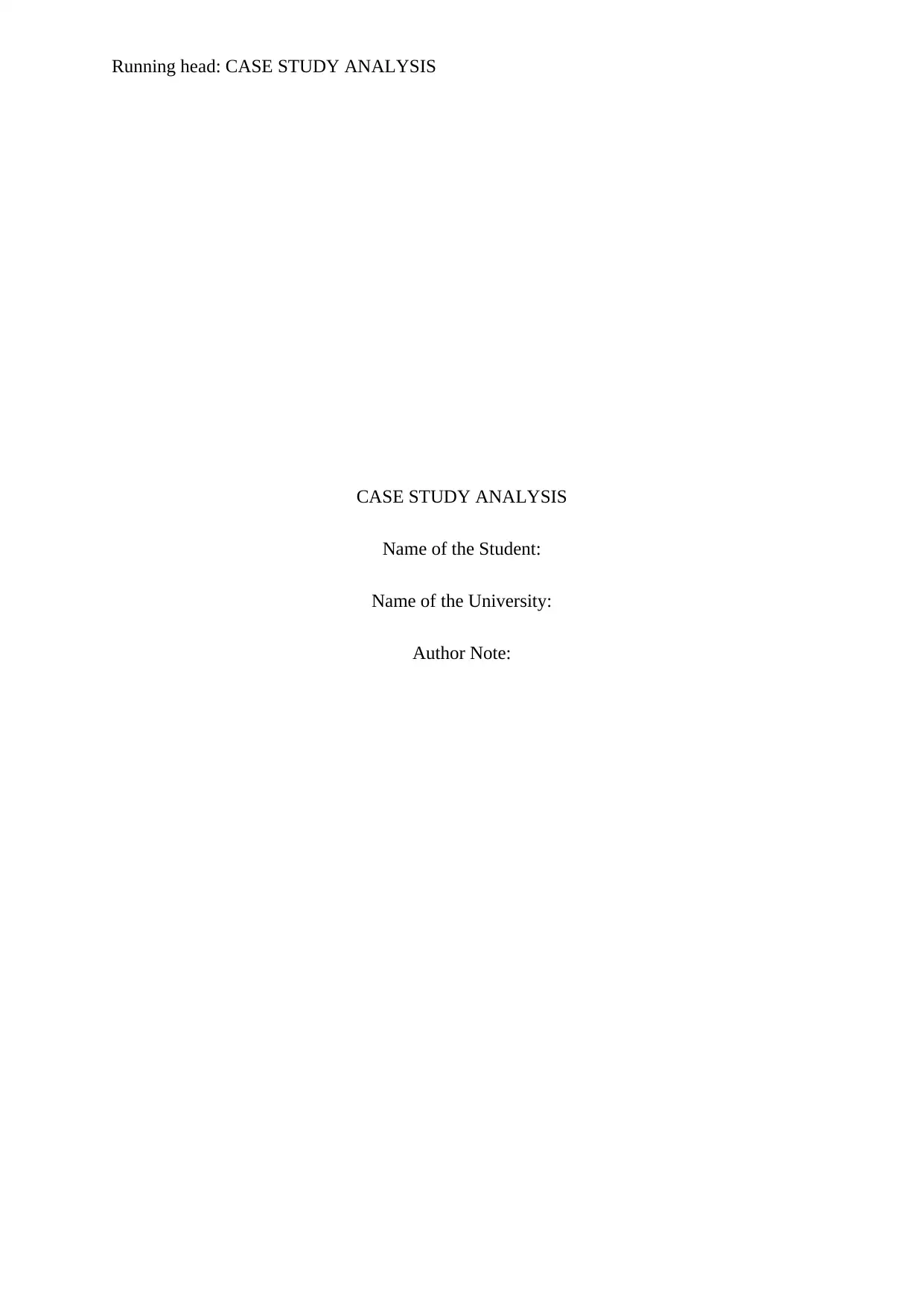
Running head: CASE STUDY ANALYSIS
CASE STUDY ANALYSIS
Name of the Student:
Name of the University:
Author Note:
CASE STUDY ANALYSIS
Name of the Student:
Name of the University:
Author Note:
Paraphrase This Document
Need a fresh take? Get an instant paraphrase of this document with our AI Paraphraser
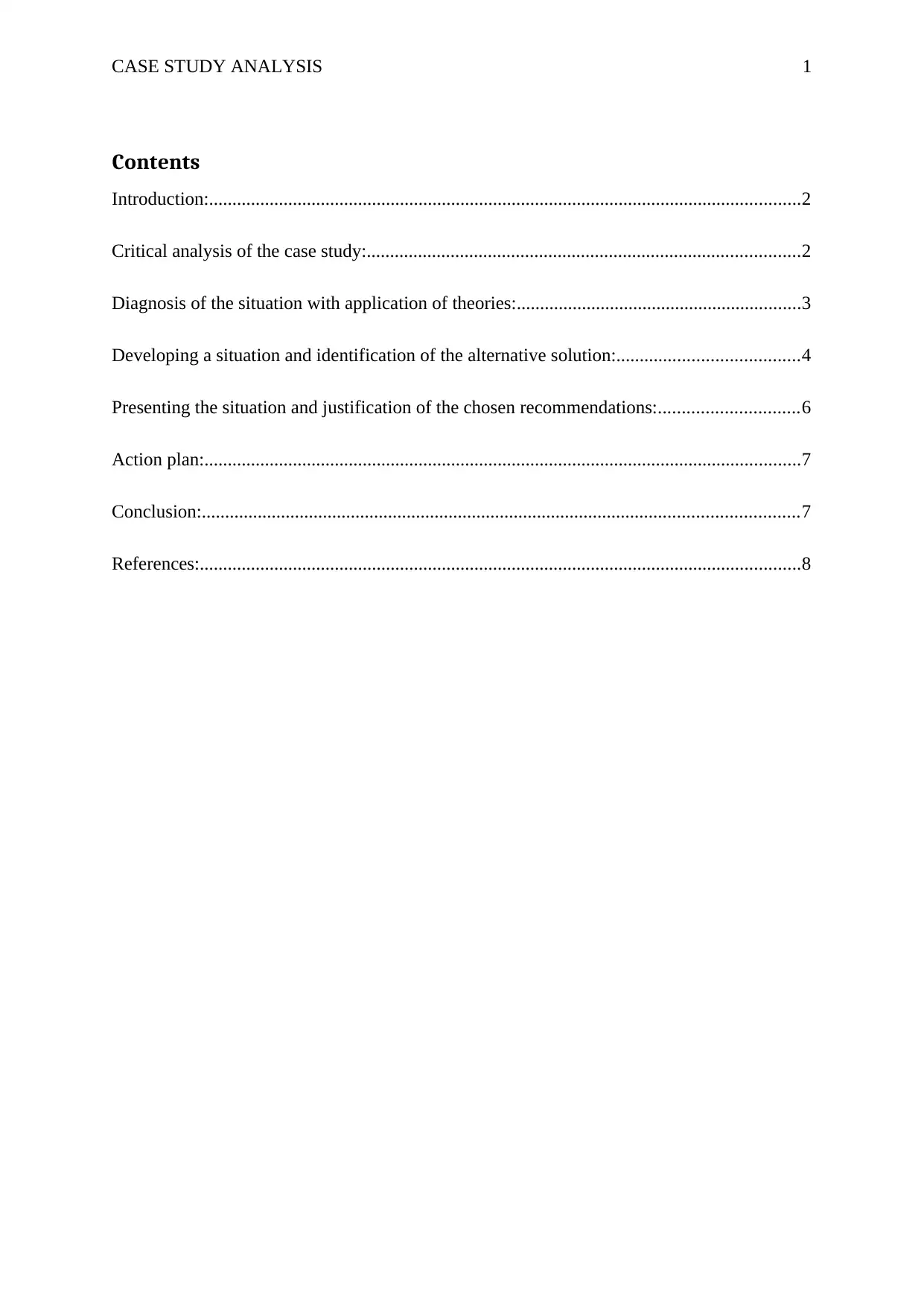
CASE STUDY ANALYSIS 1
Contents
Introduction:...............................................................................................................................2
Critical analysis of the case study:.............................................................................................2
Diagnosis of the situation with application of theories:.............................................................3
Developing a situation and identification of the alternative solution:.......................................4
Presenting the situation and justification of the chosen recommendations:..............................6
Action plan:................................................................................................................................7
Conclusion:................................................................................................................................7
References:.................................................................................................................................8
Contents
Introduction:...............................................................................................................................2
Critical analysis of the case study:.............................................................................................2
Diagnosis of the situation with application of theories:.............................................................3
Developing a situation and identification of the alternative solution:.......................................4
Presenting the situation and justification of the chosen recommendations:..............................6
Action plan:................................................................................................................................7
Conclusion:................................................................................................................................7
References:.................................................................................................................................8
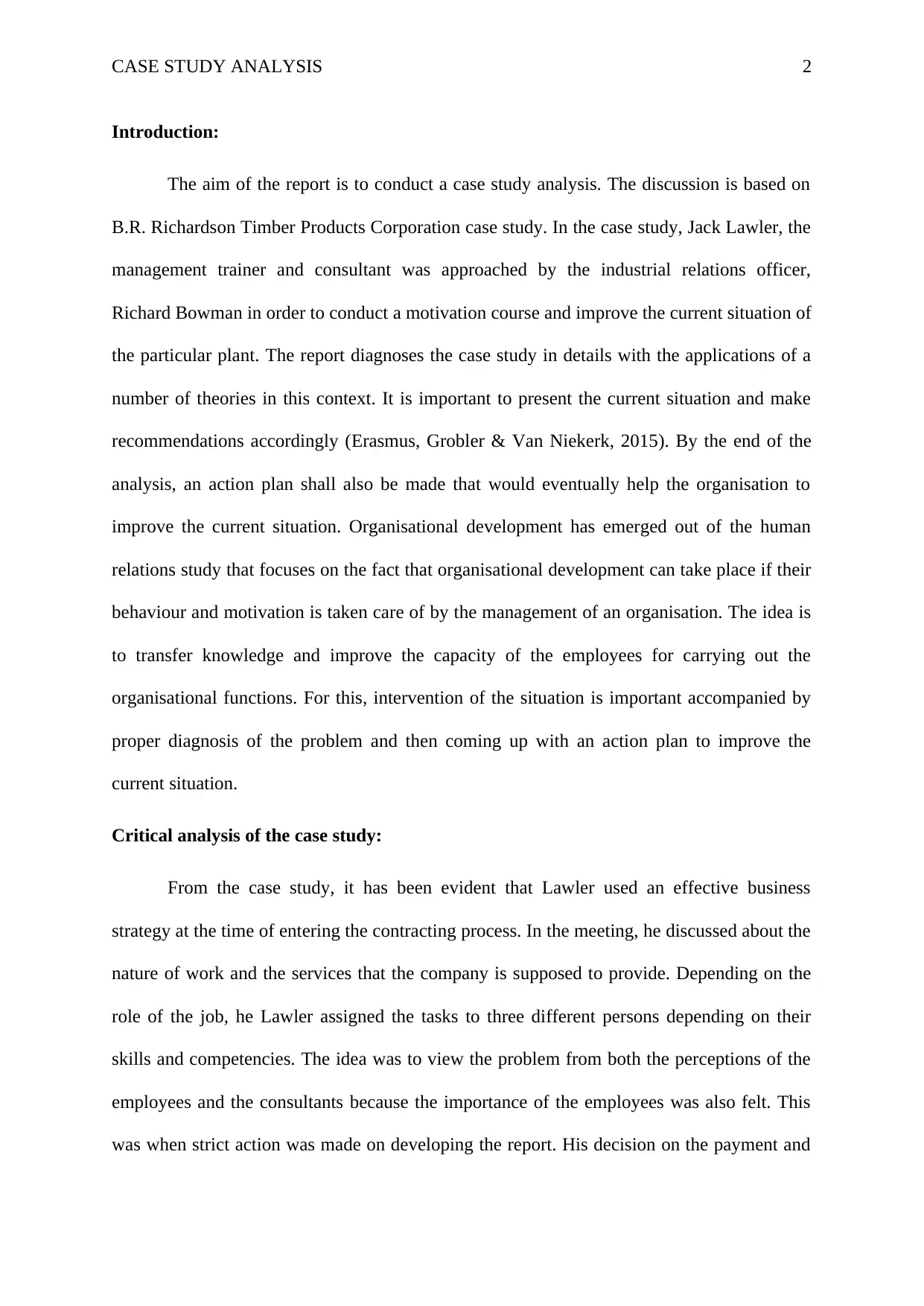
CASE STUDY ANALYSIS 2
Introduction:
The aim of the report is to conduct a case study analysis. The discussion is based on
B.R. Richardson Timber Products Corporation case study. In the case study, Jack Lawler, the
management trainer and consultant was approached by the industrial relations officer,
Richard Bowman in order to conduct a motivation course and improve the current situation of
the particular plant. The report diagnoses the case study in details with the applications of a
number of theories in this context. It is important to present the current situation and make
recommendations accordingly (Erasmus, Grobler & Van Niekerk, 2015). By the end of the
analysis, an action plan shall also be made that would eventually help the organisation to
improve the current situation. Organisational development has emerged out of the human
relations study that focuses on the fact that organisational development can take place if their
behaviour and motivation is taken care of by the management of an organisation. The idea is
to transfer knowledge and improve the capacity of the employees for carrying out the
organisational functions. For this, intervention of the situation is important accompanied by
proper diagnosis of the problem and then coming up with an action plan to improve the
current situation.
Critical analysis of the case study:
From the case study, it has been evident that Lawler used an effective business
strategy at the time of entering the contracting process. In the meeting, he discussed about the
nature of work and the services that the company is supposed to provide. Depending on the
role of the job, he Lawler assigned the tasks to three different persons depending on their
skills and competencies. The idea was to view the problem from both the perceptions of the
employees and the consultants because the importance of the employees was also felt. This
was when strict action was made on developing the report. His decision on the payment and
Introduction:
The aim of the report is to conduct a case study analysis. The discussion is based on
B.R. Richardson Timber Products Corporation case study. In the case study, Jack Lawler, the
management trainer and consultant was approached by the industrial relations officer,
Richard Bowman in order to conduct a motivation course and improve the current situation of
the particular plant. The report diagnoses the case study in details with the applications of a
number of theories in this context. It is important to present the current situation and make
recommendations accordingly (Erasmus, Grobler & Van Niekerk, 2015). By the end of the
analysis, an action plan shall also be made that would eventually help the organisation to
improve the current situation. Organisational development has emerged out of the human
relations study that focuses on the fact that organisational development can take place if their
behaviour and motivation is taken care of by the management of an organisation. The idea is
to transfer knowledge and improve the capacity of the employees for carrying out the
organisational functions. For this, intervention of the situation is important accompanied by
proper diagnosis of the problem and then coming up with an action plan to improve the
current situation.
Critical analysis of the case study:
From the case study, it has been evident that Lawler used an effective business
strategy at the time of entering the contracting process. In the meeting, he discussed about the
nature of work and the services that the company is supposed to provide. Depending on the
role of the job, he Lawler assigned the tasks to three different persons depending on their
skills and competencies. The idea was to view the problem from both the perceptions of the
employees and the consultants because the importance of the employees was also felt. This
was when strict action was made on developing the report. His decision on the payment and
⊘ This is a preview!⊘
Do you want full access?
Subscribe today to unlock all pages.

Trusted by 1+ million students worldwide
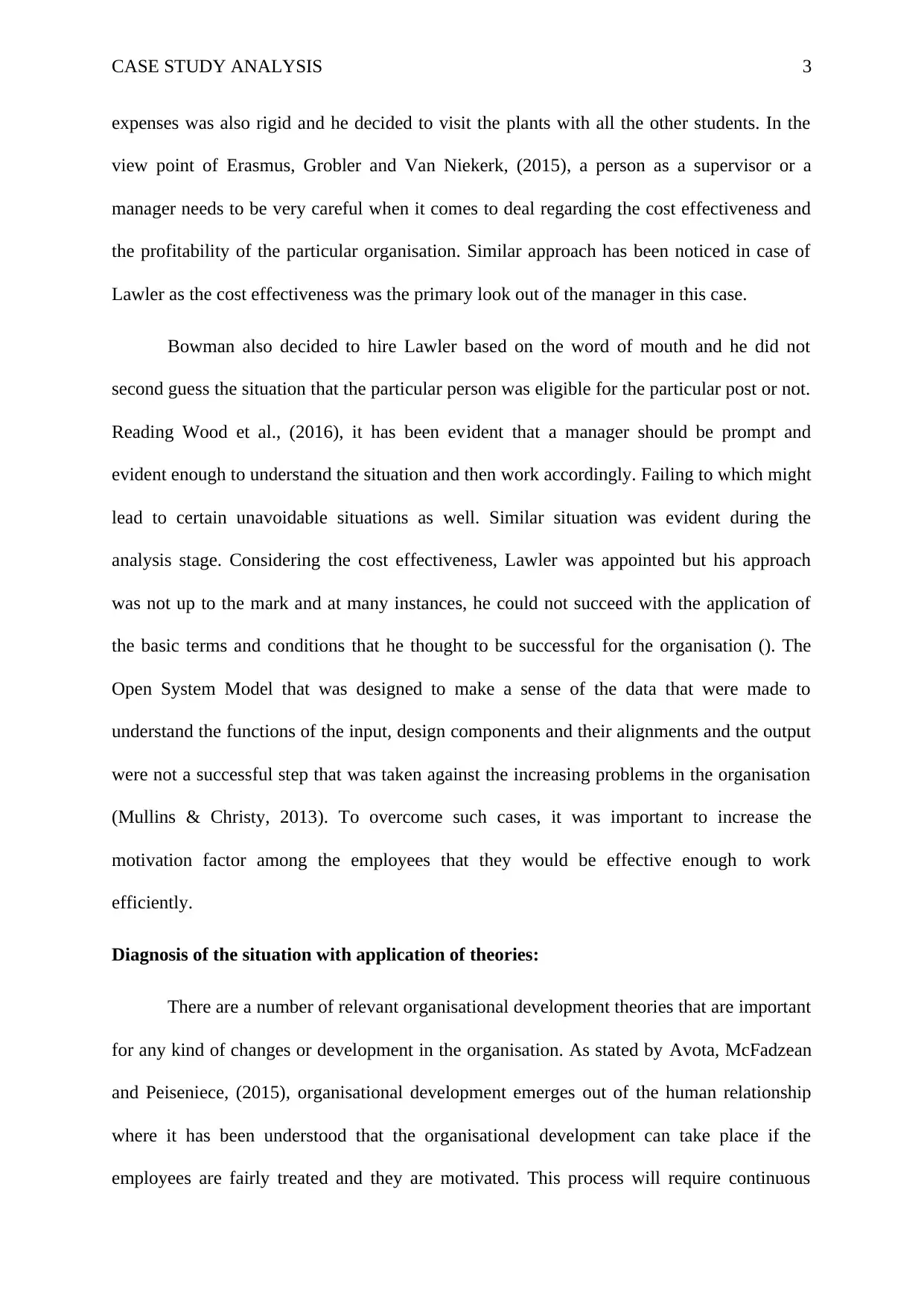
CASE STUDY ANALYSIS 3
expenses was also rigid and he decided to visit the plants with all the other students. In the
view point of Erasmus, Grobler and Van Niekerk, (2015), a person as a supervisor or a
manager needs to be very careful when it comes to deal regarding the cost effectiveness and
the profitability of the particular organisation. Similar approach has been noticed in case of
Lawler as the cost effectiveness was the primary look out of the manager in this case.
Bowman also decided to hire Lawler based on the word of mouth and he did not
second guess the situation that the particular person was eligible for the particular post or not.
Reading Wood et al., (2016), it has been evident that a manager should be prompt and
evident enough to understand the situation and then work accordingly. Failing to which might
lead to certain unavoidable situations as well. Similar situation was evident during the
analysis stage. Considering the cost effectiveness, Lawler was appointed but his approach
was not up to the mark and at many instances, he could not succeed with the application of
the basic terms and conditions that he thought to be successful for the organisation (). The
Open System Model that was designed to make a sense of the data that were made to
understand the functions of the input, design components and their alignments and the output
were not a successful step that was taken against the increasing problems in the organisation
(Mullins & Christy, 2013). To overcome such cases, it was important to increase the
motivation factor among the employees that they would be effective enough to work
efficiently.
Diagnosis of the situation with application of theories:
There are a number of relevant organisational development theories that are important
for any kind of changes or development in the organisation. As stated by Avota, McFadzean
and Peiseniece, (2015), organisational development emerges out of the human relationship
where it has been understood that the organisational development can take place if the
employees are fairly treated and they are motivated. This process will require continuous
expenses was also rigid and he decided to visit the plants with all the other students. In the
view point of Erasmus, Grobler and Van Niekerk, (2015), a person as a supervisor or a
manager needs to be very careful when it comes to deal regarding the cost effectiveness and
the profitability of the particular organisation. Similar approach has been noticed in case of
Lawler as the cost effectiveness was the primary look out of the manager in this case.
Bowman also decided to hire Lawler based on the word of mouth and he did not
second guess the situation that the particular person was eligible for the particular post or not.
Reading Wood et al., (2016), it has been evident that a manager should be prompt and
evident enough to understand the situation and then work accordingly. Failing to which might
lead to certain unavoidable situations as well. Similar situation was evident during the
analysis stage. Considering the cost effectiveness, Lawler was appointed but his approach
was not up to the mark and at many instances, he could not succeed with the application of
the basic terms and conditions that he thought to be successful for the organisation (). The
Open System Model that was designed to make a sense of the data that were made to
understand the functions of the input, design components and their alignments and the output
were not a successful step that was taken against the increasing problems in the organisation
(Mullins & Christy, 2013). To overcome such cases, it was important to increase the
motivation factor among the employees that they would be effective enough to work
efficiently.
Diagnosis of the situation with application of theories:
There are a number of relevant organisational development theories that are important
for any kind of changes or development in the organisation. As stated by Avota, McFadzean
and Peiseniece, (2015), organisational development emerges out of the human relationship
where it has been understood that the organisational development can take place if the
employees are fairly treated and they are motivated. This process will require continuous
Paraphrase This Document
Need a fresh take? Get an instant paraphrase of this document with our AI Paraphraser
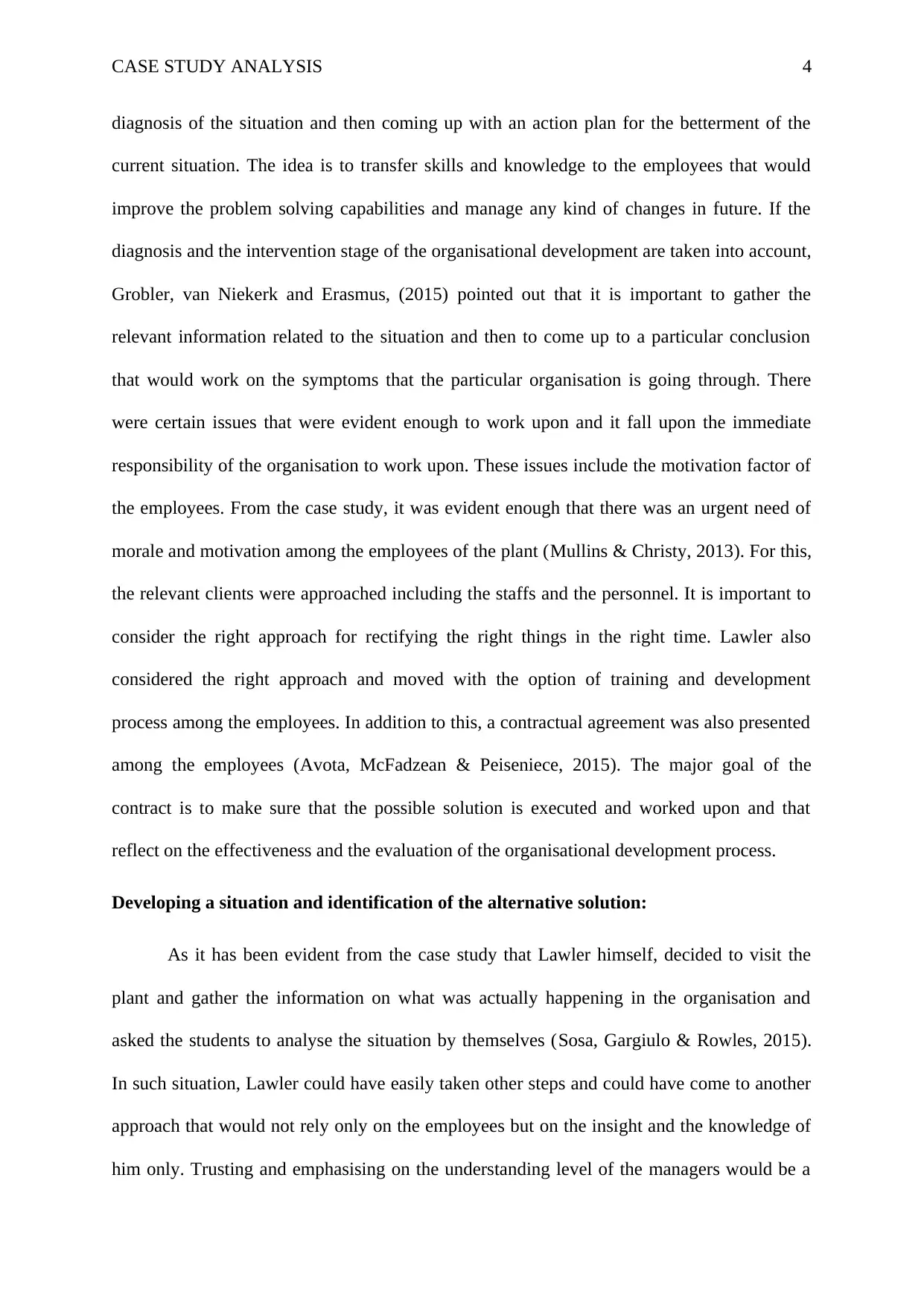
CASE STUDY ANALYSIS 4
diagnosis of the situation and then coming up with an action plan for the betterment of the
current situation. The idea is to transfer skills and knowledge to the employees that would
improve the problem solving capabilities and manage any kind of changes in future. If the
diagnosis and the intervention stage of the organisational development are taken into account,
Grobler, van Niekerk and Erasmus, (2015) pointed out that it is important to gather the
relevant information related to the situation and then to come up to a particular conclusion
that would work on the symptoms that the particular organisation is going through. There
were certain issues that were evident enough to work upon and it fall upon the immediate
responsibility of the organisation to work upon. These issues include the motivation factor of
the employees. From the case study, it was evident enough that there was an urgent need of
morale and motivation among the employees of the plant (Mullins & Christy, 2013). For this,
the relevant clients were approached including the staffs and the personnel. It is important to
consider the right approach for rectifying the right things in the right time. Lawler also
considered the right approach and moved with the option of training and development
process among the employees. In addition to this, a contractual agreement was also presented
among the employees (Avota, McFadzean & Peiseniece, 2015). The major goal of the
contract is to make sure that the possible solution is executed and worked upon and that
reflect on the effectiveness and the evaluation of the organisational development process.
Developing a situation and identification of the alternative solution:
As it has been evident from the case study that Lawler himself, decided to visit the
plant and gather the information on what was actually happening in the organisation and
asked the students to analyse the situation by themselves (Sosa, Gargiulo & Rowles, 2015).
In such situation, Lawler could have easily taken other steps and could have come to another
approach that would not rely only on the employees but on the insight and the knowledge of
him only. Trusting and emphasising on the understanding level of the managers would be a
diagnosis of the situation and then coming up with an action plan for the betterment of the
current situation. The idea is to transfer skills and knowledge to the employees that would
improve the problem solving capabilities and manage any kind of changes in future. If the
diagnosis and the intervention stage of the organisational development are taken into account,
Grobler, van Niekerk and Erasmus, (2015) pointed out that it is important to gather the
relevant information related to the situation and then to come up to a particular conclusion
that would work on the symptoms that the particular organisation is going through. There
were certain issues that were evident enough to work upon and it fall upon the immediate
responsibility of the organisation to work upon. These issues include the motivation factor of
the employees. From the case study, it was evident enough that there was an urgent need of
morale and motivation among the employees of the plant (Mullins & Christy, 2013). For this,
the relevant clients were approached including the staffs and the personnel. It is important to
consider the right approach for rectifying the right things in the right time. Lawler also
considered the right approach and moved with the option of training and development
process among the employees. In addition to this, a contractual agreement was also presented
among the employees (Avota, McFadzean & Peiseniece, 2015). The major goal of the
contract is to make sure that the possible solution is executed and worked upon and that
reflect on the effectiveness and the evaluation of the organisational development process.
Developing a situation and identification of the alternative solution:
As it has been evident from the case study that Lawler himself, decided to visit the
plant and gather the information on what was actually happening in the organisation and
asked the students to analyse the situation by themselves (Sosa, Gargiulo & Rowles, 2015).
In such situation, Lawler could have easily taken other steps and could have come to another
approach that would not rely only on the employees but on the insight and the knowledge of
him only. Trusting and emphasising on the understanding level of the managers would be a
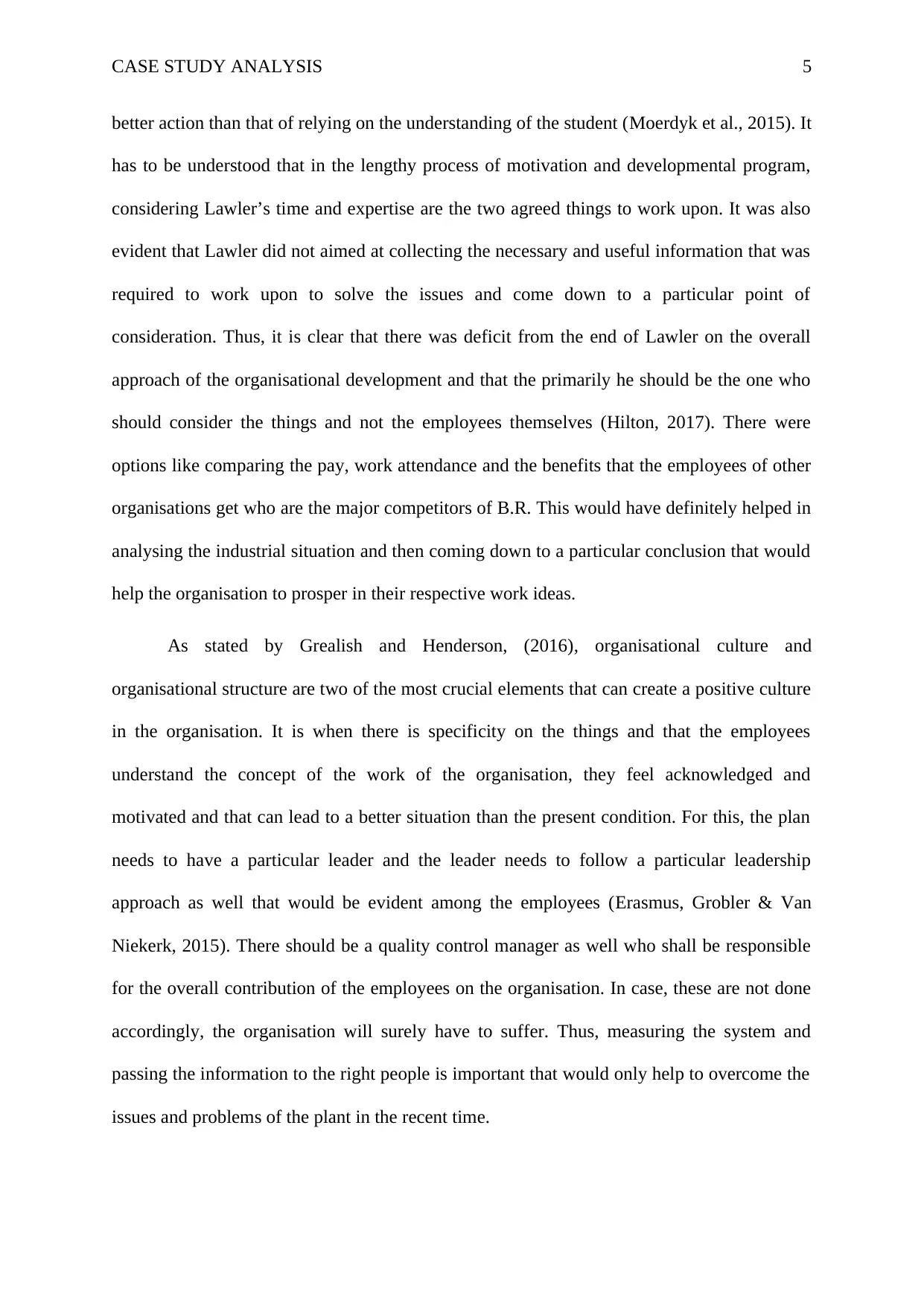
CASE STUDY ANALYSIS 5
better action than that of relying on the understanding of the student (Moerdyk et al., 2015). It
has to be understood that in the lengthy process of motivation and developmental program,
considering Lawler’s time and expertise are the two agreed things to work upon. It was also
evident that Lawler did not aimed at collecting the necessary and useful information that was
required to work upon to solve the issues and come down to a particular point of
consideration. Thus, it is clear that there was deficit from the end of Lawler on the overall
approach of the organisational development and that the primarily he should be the one who
should consider the things and not the employees themselves (Hilton, 2017). There were
options like comparing the pay, work attendance and the benefits that the employees of other
organisations get who are the major competitors of B.R. This would have definitely helped in
analysing the industrial situation and then coming down to a particular conclusion that would
help the organisation to prosper in their respective work ideas.
As stated by Grealish and Henderson, (2016), organisational culture and
organisational structure are two of the most crucial elements that can create a positive culture
in the organisation. It is when there is specificity on the things and that the employees
understand the concept of the work of the organisation, they feel acknowledged and
motivated and that can lead to a better situation than the present condition. For this, the plan
needs to have a particular leader and the leader needs to follow a particular leadership
approach as well that would be evident among the employees (Erasmus, Grobler & Van
Niekerk, 2015). There should be a quality control manager as well who shall be responsible
for the overall contribution of the employees on the organisation. In case, these are not done
accordingly, the organisation will surely have to suffer. Thus, measuring the system and
passing the information to the right people is important that would only help to overcome the
issues and problems of the plant in the recent time.
better action than that of relying on the understanding of the student (Moerdyk et al., 2015). It
has to be understood that in the lengthy process of motivation and developmental program,
considering Lawler’s time and expertise are the two agreed things to work upon. It was also
evident that Lawler did not aimed at collecting the necessary and useful information that was
required to work upon to solve the issues and come down to a particular point of
consideration. Thus, it is clear that there was deficit from the end of Lawler on the overall
approach of the organisational development and that the primarily he should be the one who
should consider the things and not the employees themselves (Hilton, 2017). There were
options like comparing the pay, work attendance and the benefits that the employees of other
organisations get who are the major competitors of B.R. This would have definitely helped in
analysing the industrial situation and then coming down to a particular conclusion that would
help the organisation to prosper in their respective work ideas.
As stated by Grealish and Henderson, (2016), organisational culture and
organisational structure are two of the most crucial elements that can create a positive culture
in the organisation. It is when there is specificity on the things and that the employees
understand the concept of the work of the organisation, they feel acknowledged and
motivated and that can lead to a better situation than the present condition. For this, the plan
needs to have a particular leader and the leader needs to follow a particular leadership
approach as well that would be evident among the employees (Erasmus, Grobler & Van
Niekerk, 2015). There should be a quality control manager as well who shall be responsible
for the overall contribution of the employees on the organisation. In case, these are not done
accordingly, the organisation will surely have to suffer. Thus, measuring the system and
passing the information to the right people is important that would only help to overcome the
issues and problems of the plant in the recent time.
⊘ This is a preview!⊘
Do you want full access?
Subscribe today to unlock all pages.

Trusted by 1+ million students worldwide
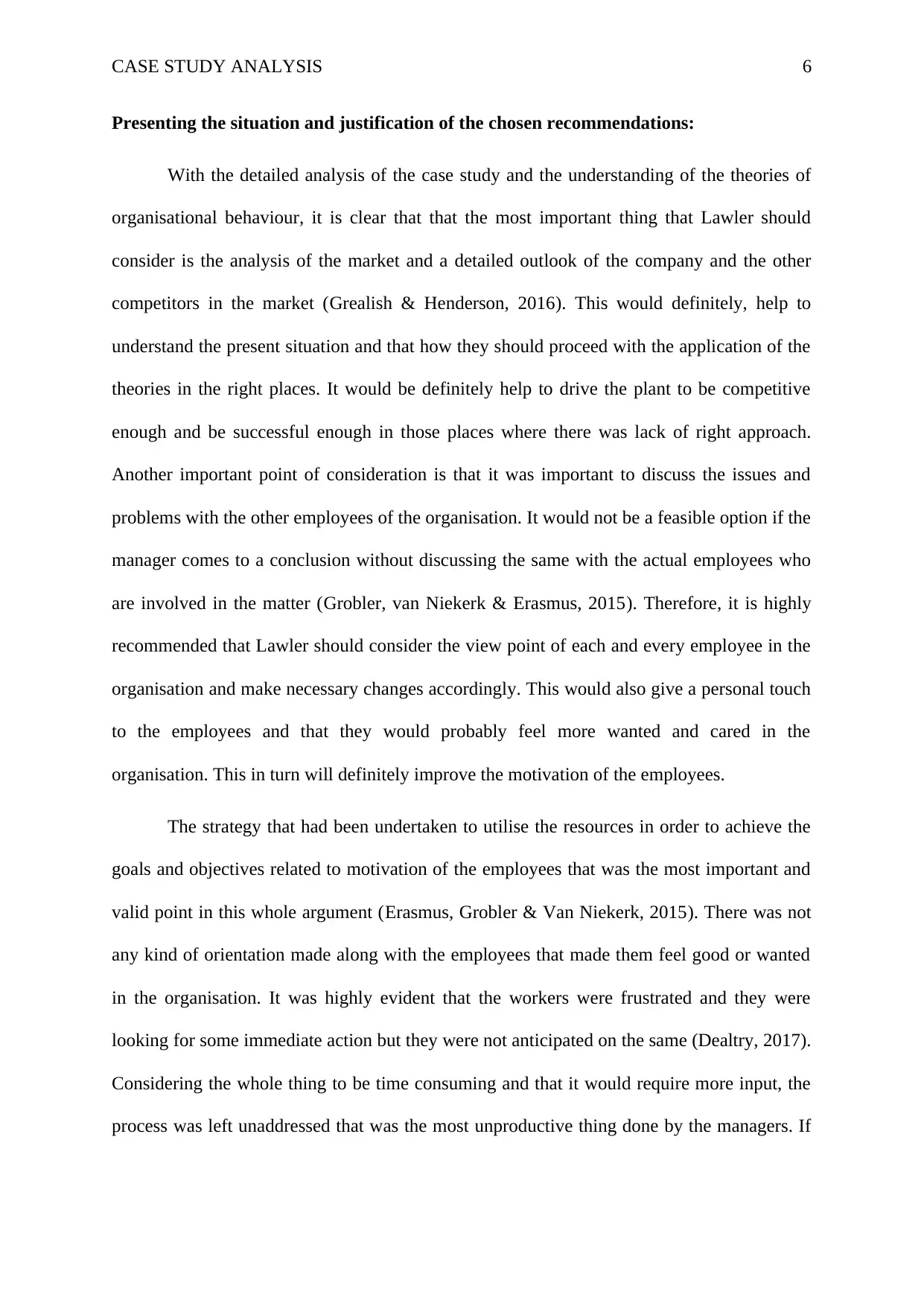
CASE STUDY ANALYSIS 6
Presenting the situation and justification of the chosen recommendations:
With the detailed analysis of the case study and the understanding of the theories of
organisational behaviour, it is clear that that the most important thing that Lawler should
consider is the analysis of the market and a detailed outlook of the company and the other
competitors in the market (Grealish & Henderson, 2016). This would definitely, help to
understand the present situation and that how they should proceed with the application of the
theories in the right places. It would be definitely help to drive the plant to be competitive
enough and be successful enough in those places where there was lack of right approach.
Another important point of consideration is that it was important to discuss the issues and
problems with the other employees of the organisation. It would not be a feasible option if the
manager comes to a conclusion without discussing the same with the actual employees who
are involved in the matter (Grobler, van Niekerk & Erasmus, 2015). Therefore, it is highly
recommended that Lawler should consider the view point of each and every employee in the
organisation and make necessary changes accordingly. This would also give a personal touch
to the employees and that they would probably feel more wanted and cared in the
organisation. This in turn will definitely improve the motivation of the employees.
The strategy that had been undertaken to utilise the resources in order to achieve the
goals and objectives related to motivation of the employees that was the most important and
valid point in this whole argument (Erasmus, Grobler & Van Niekerk, 2015). There was not
any kind of orientation made along with the employees that made them feel good or wanted
in the organisation. It was highly evident that the workers were frustrated and they were
looking for some immediate action but they were not anticipated on the same (Dealtry, 2017).
Considering the whole thing to be time consuming and that it would require more input, the
process was left unaddressed that was the most unproductive thing done by the managers. If
Presenting the situation and justification of the chosen recommendations:
With the detailed analysis of the case study and the understanding of the theories of
organisational behaviour, it is clear that that the most important thing that Lawler should
consider is the analysis of the market and a detailed outlook of the company and the other
competitors in the market (Grealish & Henderson, 2016). This would definitely, help to
understand the present situation and that how they should proceed with the application of the
theories in the right places. It would be definitely help to drive the plant to be competitive
enough and be successful enough in those places where there was lack of right approach.
Another important point of consideration is that it was important to discuss the issues and
problems with the other employees of the organisation. It would not be a feasible option if the
manager comes to a conclusion without discussing the same with the actual employees who
are involved in the matter (Grobler, van Niekerk & Erasmus, 2015). Therefore, it is highly
recommended that Lawler should consider the view point of each and every employee in the
organisation and make necessary changes accordingly. This would also give a personal touch
to the employees and that they would probably feel more wanted and cared in the
organisation. This in turn will definitely improve the motivation of the employees.
The strategy that had been undertaken to utilise the resources in order to achieve the
goals and objectives related to motivation of the employees that was the most important and
valid point in this whole argument (Erasmus, Grobler & Van Niekerk, 2015). There was not
any kind of orientation made along with the employees that made them feel good or wanted
in the organisation. It was highly evident that the workers were frustrated and they were
looking for some immediate action but they were not anticipated on the same (Dealtry, 2017).
Considering the whole thing to be time consuming and that it would require more input, the
process was left unaddressed that was the most unproductive thing done by the managers. If
Paraphrase This Document
Need a fresh take? Get an instant paraphrase of this document with our AI Paraphraser
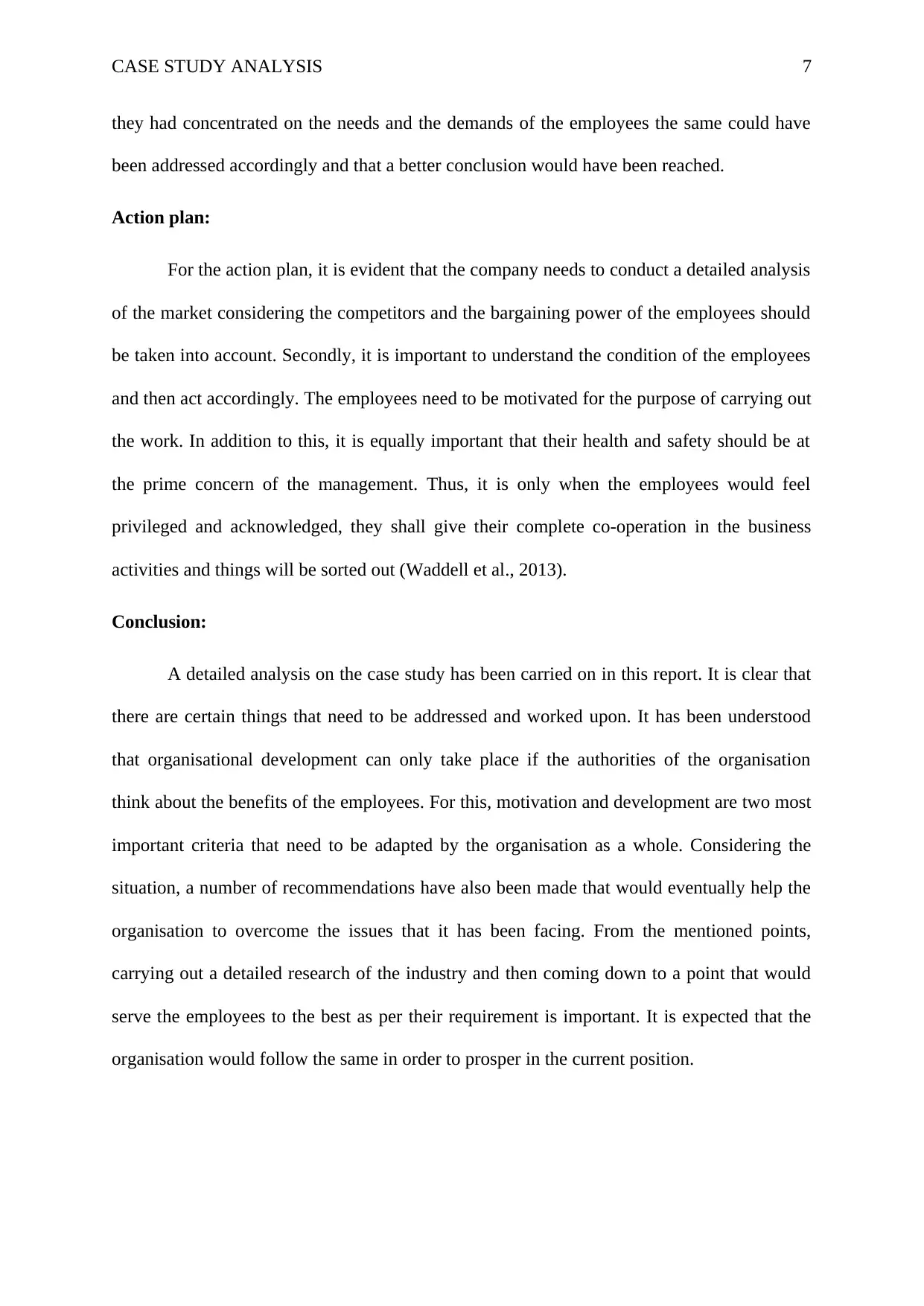
CASE STUDY ANALYSIS 7
they had concentrated on the needs and the demands of the employees the same could have
been addressed accordingly and that a better conclusion would have been reached.
Action plan:
For the action plan, it is evident that the company needs to conduct a detailed analysis
of the market considering the competitors and the bargaining power of the employees should
be taken into account. Secondly, it is important to understand the condition of the employees
and then act accordingly. The employees need to be motivated for the purpose of carrying out
the work. In addition to this, it is equally important that their health and safety should be at
the prime concern of the management. Thus, it is only when the employees would feel
privileged and acknowledged, they shall give their complete co-operation in the business
activities and things will be sorted out (Waddell et al., 2013).
Conclusion:
A detailed analysis on the case study has been carried on in this report. It is clear that
there are certain things that need to be addressed and worked upon. It has been understood
that organisational development can only take place if the authorities of the organisation
think about the benefits of the employees. For this, motivation and development are two most
important criteria that need to be adapted by the organisation as a whole. Considering the
situation, a number of recommendations have also been made that would eventually help the
organisation to overcome the issues that it has been facing. From the mentioned points,
carrying out a detailed research of the industry and then coming down to a point that would
serve the employees to the best as per their requirement is important. It is expected that the
organisation would follow the same in order to prosper in the current position.
they had concentrated on the needs and the demands of the employees the same could have
been addressed accordingly and that a better conclusion would have been reached.
Action plan:
For the action plan, it is evident that the company needs to conduct a detailed analysis
of the market considering the competitors and the bargaining power of the employees should
be taken into account. Secondly, it is important to understand the condition of the employees
and then act accordingly. The employees need to be motivated for the purpose of carrying out
the work. In addition to this, it is equally important that their health and safety should be at
the prime concern of the management. Thus, it is only when the employees would feel
privileged and acknowledged, they shall give their complete co-operation in the business
activities and things will be sorted out (Waddell et al., 2013).
Conclusion:
A detailed analysis on the case study has been carried on in this report. It is clear that
there are certain things that need to be addressed and worked upon. It has been understood
that organisational development can only take place if the authorities of the organisation
think about the benefits of the employees. For this, motivation and development are two most
important criteria that need to be adapted by the organisation as a whole. Considering the
situation, a number of recommendations have also been made that would eventually help the
organisation to overcome the issues that it has been facing. From the mentioned points,
carrying out a detailed research of the industry and then coming down to a point that would
serve the employees to the best as per their requirement is important. It is expected that the
organisation would follow the same in order to prosper in the current position.
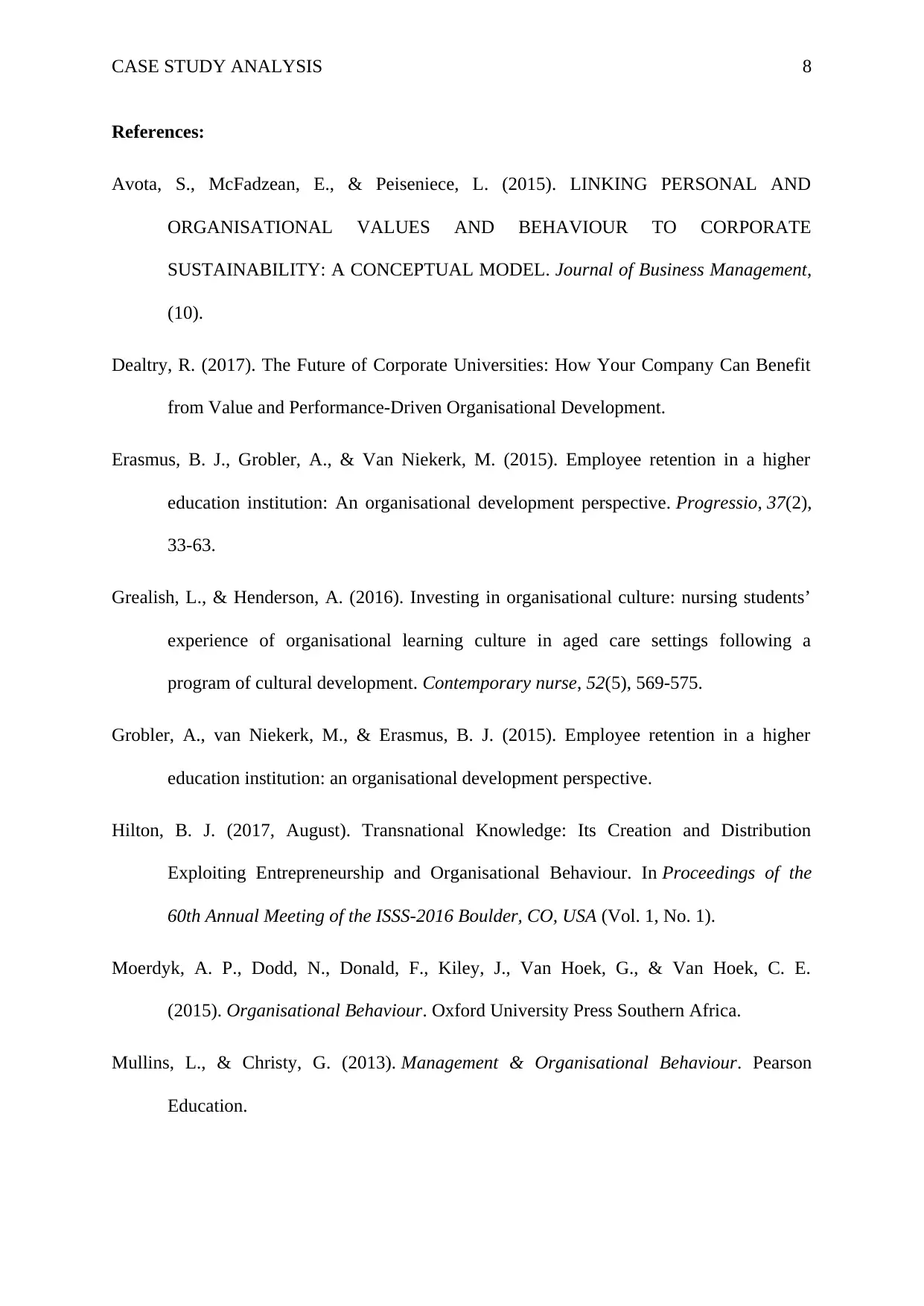
CASE STUDY ANALYSIS 8
References:
Avota, S., McFadzean, E., & Peiseniece, L. (2015). LINKING PERSONAL AND
ORGANISATIONAL VALUES AND BEHAVIOUR TO CORPORATE
SUSTAINABILITY: A CONCEPTUAL MODEL. Journal of Business Management,
(10).
Dealtry, R. (2017). The Future of Corporate Universities: How Your Company Can Benefit
from Value and Performance-Driven Organisational Development.
Erasmus, B. J., Grobler, A., & Van Niekerk, M. (2015). Employee retention in a higher
education institution: An organisational development perspective. Progressio, 37(2),
33-63.
Grealish, L., & Henderson, A. (2016). Investing in organisational culture: nursing students’
experience of organisational learning culture in aged care settings following a
program of cultural development. Contemporary nurse, 52(5), 569-575.
Grobler, A., van Niekerk, M., & Erasmus, B. J. (2015). Employee retention in a higher
education institution: an organisational development perspective.
Hilton, B. J. (2017, August). Transnational Knowledge: Its Creation and Distribution
Exploiting Entrepreneurship and Organisational Behaviour. In Proceedings of the
60th Annual Meeting of the ISSS-2016 Boulder, CO, USA (Vol. 1, No. 1).
Moerdyk, A. P., Dodd, N., Donald, F., Kiley, J., Van Hoek, G., & Van Hoek, C. E.
(2015). Organisational Behaviour. Oxford University Press Southern Africa.
Mullins, L., & Christy, G. (2013). Management & Organisational Behaviour. Pearson
Education.
References:
Avota, S., McFadzean, E., & Peiseniece, L. (2015). LINKING PERSONAL AND
ORGANISATIONAL VALUES AND BEHAVIOUR TO CORPORATE
SUSTAINABILITY: A CONCEPTUAL MODEL. Journal of Business Management,
(10).
Dealtry, R. (2017). The Future of Corporate Universities: How Your Company Can Benefit
from Value and Performance-Driven Organisational Development.
Erasmus, B. J., Grobler, A., & Van Niekerk, M. (2015). Employee retention in a higher
education institution: An organisational development perspective. Progressio, 37(2),
33-63.
Grealish, L., & Henderson, A. (2016). Investing in organisational culture: nursing students’
experience of organisational learning culture in aged care settings following a
program of cultural development. Contemporary nurse, 52(5), 569-575.
Grobler, A., van Niekerk, M., & Erasmus, B. J. (2015). Employee retention in a higher
education institution: an organisational development perspective.
Hilton, B. J. (2017, August). Transnational Knowledge: Its Creation and Distribution
Exploiting Entrepreneurship and Organisational Behaviour. In Proceedings of the
60th Annual Meeting of the ISSS-2016 Boulder, CO, USA (Vol. 1, No. 1).
Moerdyk, A. P., Dodd, N., Donald, F., Kiley, J., Van Hoek, G., & Van Hoek, C. E.
(2015). Organisational Behaviour. Oxford University Press Southern Africa.
Mullins, L., & Christy, G. (2013). Management & Organisational Behaviour. Pearson
Education.
⊘ This is a preview!⊘
Do you want full access?
Subscribe today to unlock all pages.

Trusted by 1+ million students worldwide
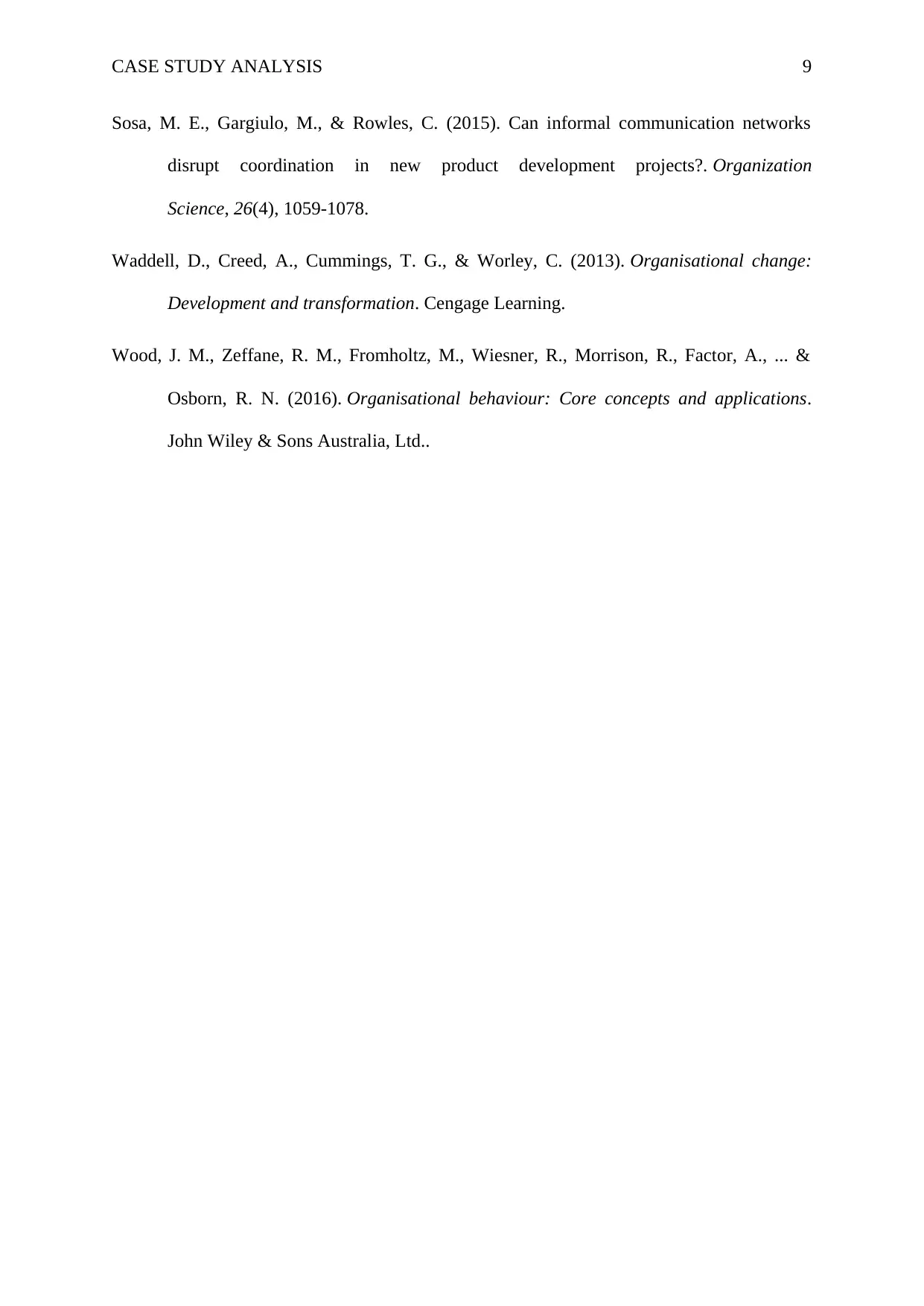
CASE STUDY ANALYSIS 9
Sosa, M. E., Gargiulo, M., & Rowles, C. (2015). Can informal communication networks
disrupt coordination in new product development projects?. Organization
Science, 26(4), 1059-1078.
Waddell, D., Creed, A., Cummings, T. G., & Worley, C. (2013). Organisational change:
Development and transformation. Cengage Learning.
Wood, J. M., Zeffane, R. M., Fromholtz, M., Wiesner, R., Morrison, R., Factor, A., ... &
Osborn, R. N. (2016). Organisational behaviour: Core concepts and applications.
John Wiley & Sons Australia, Ltd..
Sosa, M. E., Gargiulo, M., & Rowles, C. (2015). Can informal communication networks
disrupt coordination in new product development projects?. Organization
Science, 26(4), 1059-1078.
Waddell, D., Creed, A., Cummings, T. G., & Worley, C. (2013). Organisational change:
Development and transformation. Cengage Learning.
Wood, J. M., Zeffane, R. M., Fromholtz, M., Wiesner, R., Morrison, R., Factor, A., ... &
Osborn, R. N. (2016). Organisational behaviour: Core concepts and applications.
John Wiley & Sons Australia, Ltd..
1 out of 10
Related Documents
Your All-in-One AI-Powered Toolkit for Academic Success.
+13062052269
info@desklib.com
Available 24*7 on WhatsApp / Email
![[object Object]](/_next/static/media/star-bottom.7253800d.svg)
Unlock your academic potential
Copyright © 2020–2025 A2Z Services. All Rights Reserved. Developed and managed by ZUCOL.




